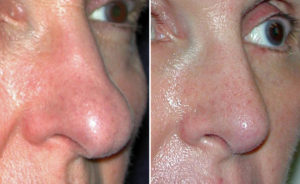Rhinoplasty patients are understandably interested in knowing how their plastic surgeon thinks in analyzing their nose for surgery. Perhaps in this quest they are really interested in knowing if what bothers them is what their plastic surgeon sees. While photographic analysis and computer imaging are keys in this communication process, experienced plastic surgeons certainly get a near instantaneous impression of the issues.
In just a few minutes, plastic surgeons certainly get a first impression of one’s nose. It may be seen as having a large hump, a big and wide tip, or a nose that is overall just too big. It may be seen as being deviated or twisted or it might be an overreduced nose that needs revision. In any case, this first impression is usually remarkably accurate and is quite likely to be exactly what bothers the patient as well. This is confirmed by asking the patient early on as to what bothers them and what their goals are.

The upper third of the nose (hump area) can be either too high or too low relative to the tip of the nose. Is it a hump that needs reduction or a bridge that needs to be built up? Is the bridge area too wide and needs to be narrowed? The middle third of the nose is more about width. Is it too narrow and needs to be widened slightly (spreader grafts) and does the patient have any breathing problems? The tip or lower third of the nose is the most dimensionally complex. Is it too wide, too long, or downturned too much? Or is it too short and upturned? Is the nose straight and, if it is twisted, what part(s) of the nose are causing it? Lastly, how is the skin thickness? Thick skin will hide many tip changes and will have more and prolonged swelling after surgery, thin skin is unforgiving and will eventually show any irregularity.
Blending these basic characteristics into a sequence of steps for the operation… and ending up with an overall improved nasal shape and proportions is the art of rhinoplasty. Conveying this operative plan to the patient and demonstrating its predicted outcome is where the important step of computer imaging comes into play.
Dr. Barry Eppley
Indianapolis, Indiana


